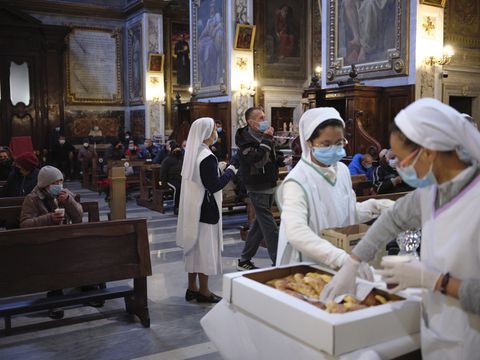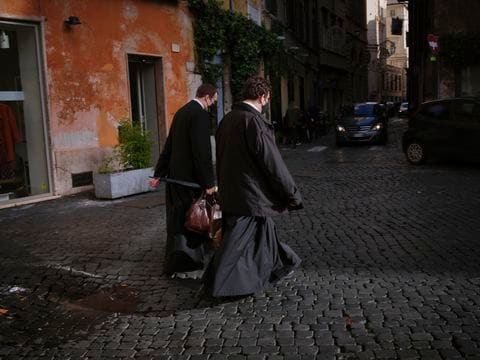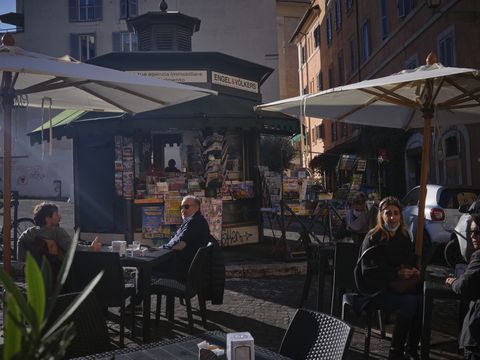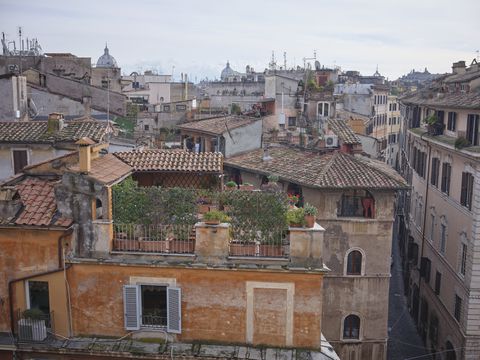On my street in Rome, the coronavirus upended two worlds
ROME — The clues of what the pandemic had wrought were up and down our street. The dry cleaner had shuttered for good. Same with the olive oil store. “For Rent” signs had gone up and stayed up, turning yellow with the months. The two-star Michelin restaurant was trying to get by on takeout orders.
Via dei Banchi Vecchi had always been a lively street, especially in the evenings, when people would spill out of the wine bar, smoking and flirting, balancing their glasses on parked cars. But now the main commotion came in the early morning, outside a church, where people were lining up in numbers that seemed to grow by the week.
They were coming for donated food.
In other years as a foreign correspondent, I might have overlooked my own neighborhood, accustomed to finding the biggest news farther from home. But the pandemic has prompted so many of us to reexamine our immediate surroundings, while at the same time leaving almost no spot untouched. I could gauge the year’s consequences by simply walking out the front door.

Colorful poinsettias fill a truck in Rome.

Marco Casandra, left, and his brother Fernando Casandra, stand in front of their cafe that on Via dei Banchi Vecchi. (Federica Valabrega for The Washington Post)
LEFT: Colorful poinsettias fill a truck in Rome. RIGHT: Marco Casandra, left, and his brother Fernando Casandra, stand in front of their cafe that on Via dei Banchi Vecchi. (Federica Valabrega for The Washington Post)
There were many ways to measure the changes. The neighborhood had gotten more intimate, stripped of the Airbnb crowds. Amid this quiet, a fight for survival — economic, emotional — edged into view, with hints of that desperation coming block by block down one of Rome’s idyllic streets.
The boutiques, once dependent on the tourist flows, were in perpetual sales mode. The corner cafe in the late summer had sought to make up for its cratered lunch crowd by refashioning itself as an aperitivo joint — longer hours, outdoor tables — only to see that concept collapse, too, when Italy two months ago tightened restrictions and imposed a nationwide curfew.
“All the shopkeepers, we talk about despair,” said Marco Casandra, 55, the coffee shop’s co-owner.
Perhaps most dramatically of all, contrasting versions of the fight had been unfolding right outside our window, where the church and the Michelin-starred restaurant are both within view. So many people have pinned their hopes on a vaccine, the idea that the crisis will be temporary, but our street was a place to grapple with the breadth of the pain, and just how top to bottom any recovery would have to be.
On one side of the street, there were people with no money to eat.
On the other side, a chef with almost nobody to serve.
 Sisters of the Claretians Order of Missionaries serve breakfast inside Santa Lucia del Gonfalone, a Roman church, to a growing number of those in need. (Federica Valabrega for The Washington Post)
Sisters of the Claretians Order of Missionaries serve breakfast inside Santa Lucia del Gonfalone, a Roman church, to a growing number of those in need. (Federica Valabrega for The Washington Post) If anything, the line outside the church underplayed what was happening inside. This was a single place trying to be a lifeline during the worst recession in modern Italian history, when the economy had shrunk 10 percent, the massive tourism sector had collapsed and a legion of off-the-books workers had nothing to fall back on.
Past the green doors, every available seat in the church was filled on a Monday morning, even as more people kept arriving. Some said they’d spent the night sleeping under bridges or in subway stations. One couple said they’d traveled two hours by bus, metro and another bus just to get here. The number of people seeking help at the church had risen 40 percent during the pandemic, to as many as 180 people in a day.
“It’s also the face of the people who are changing,” said Elaine Lombardi, 49, a nun who was passing out coffee and pastries. “It’s people who lost their jobs and now their whole lives are inside of suitcases.”
Under the frescos, people ate breakfast and took numbers for their turns in subsequent rooms. In the sacristy, volunteers helped people reload phone credit with donated money. In the crypt, people grabbed secondhand jackets, shoes and pants for the winter.
From the street, it had always been unclear to me why this particular church had become a citywide hub for the extreme poor. Nuns and volunteers, in explaining why, answered with a name: Father Francesco Incampo, known as Padre Franco.
He’d been the chaplain for 30 years, a missionary who slept in a small bedroom one building over and who’d aged along with the street. He had wispy white hair, three-times-per-week hospital appointments for dialysis, and a modest sense of what he could offer the people coming to see him — some compassion, a chance to be heard.
“Once you open the door, it’s a lost world that flows inside,” he told me in an interview.

Father Francesco Incampo hosts what he calls listening hours in a church office just steps off the street.

Secondhand clothes and shoes are available at the church for those in need. (Federica Valabrega for The Washington Post)
LEFT: Father Francesco Incampo hosts what he calls listening hours in a church office just steps off the street. RIGHT: Secondhand clothes and shoes are available at the church for those in need. (Federica Valabrega for The Washington Post)
All through the spring lockdown, he’d kept the church’s services for the poor running, and all through the second wave, he’d been carrying on his weekly schedule. Sundays, he was out on the street, bundled in a black jacket, handing out bagged lunches to a line that snaked past the enoteca. On Mondays, the biggest day of assistance, he was inside the church, calling out numbers, directing traffic. Other mornings, he was in a small office, just steps off the street, hosting what he described as listening hours, when anybody might walk up to him, drunk or sober, masked or unmasked.
“When the country was locked down, Padre Franco was the only one giving daily help,” said Maria Migliaccio, 36, who spent six months this year living under a bridge until her boyfriend found a part-time construction job. “Nobody else wanted to get close.”
Then, in November, Incampo went in for his regular dialysis and found out that he, too, was positive for the coronavirus. In order for his kidney treatments to continue, he stayed in hospital isolation for 10 days, fearing that the disease’s symptoms would start.
“I was what you might call a frail subject,” Incampo said.
But the symptoms never came.
So Incampo returned to work and restarted everything, having experienced nothing more than a “severe confinement” and feeling that he, too, had briefly felt what it was like to be viewed as a threat or pushed away.
He said the needs at the church were “never-ending.” Sometimes people came to him asking for medicine. Other times, they buzzed in the night, wanting a place to use the bathroom. On a recent Friday morning came a request for a little pocket change, from a 64-year-old man who’d previously worked until two years ago in the restaurant industry and was trying now to sell frayed men’s dress socks out of plastic bags.
Incampo handed over the contents of his pockets: two euros.
Then the man headed toward a nearby piazza, away from Via dei Banchi Vecchi, carrying what he hoped would be a day’s work: 20 euros worth of socks.
 A Saturday morning on Via dei Banchi Vecchi. (Federica Valabrega for The Washington Post)
A Saturday morning on Via dei Banchi Vecchi. (Federica Valabrega for The Washington Post) Across the street from the church, the front door of Il Pagliaccio was locked. It was 6 p.m. Behind the opaque windows of one of Rome’s most lauded restaurants, the main lights were coming from the kitchen, where chef and co-owner Anthony Genovese had a stack of takeout boxes and was beginning what he called another night of “roulette.”
“Any given day,” he said, “we don’t know if we’ll work or not.”
Genovese’s restaurant, until the pandemic, had been one of those dining temples — a place of 10-course, 185-euro tasting menus, every detail mapped and planned, down to the plates and the bathroom soaps. Romans came and so did many vacationers, including Americans. Reservations were necessary weeks in advance.
But the pandemic had turned the restaurant into something it was never meant to be, morphed by restrictions and fears. Genovese neither wanted nor had the space for outdoor tables. Il Pagliaccio was open for lunch, but some days 20 diners came — nearly full — and other days only five. As coronavirus cases spiked this fall, the Italian government banned in-person dining after 6 p.m., meaning that Genovese’s only options were to close or do takeout.
Genovese, 52, had been cooking most nights since he was a teenager. He’d already drawn up a reduced-price, takeout menu during the spring lockdown.
So evenings became all about takeout, with five or six staffers instead of the usual 18 to 20.
“It was better than watching TV at home,” he said.
The evening, a Friday, began as always: an organized kitchen, everything in place — the spices, the bottles of oil, the pork, slow-cooked and shimmering. A quiet mood music was playing. But there was nothing to do, aside from one order, already boxed up and ready. Genovese just waited.
 “Any given day,” said Anthony Genovese, the chef and co-owner of Il Pagliaccio, “we don’t know if we’ll work or not.” (Federica Valabrega for The Washington Post)
“Any given day,” said Anthony Genovese, the chef and co-owner of Il Pagliaccio, “we don’t know if we’ll work or not.” (Federica Valabrega for The Washington Post) Thirty minutes passed, then an hour. Nobody was calling. Out back, two young cooks started mapping out who would work when for the next few days. The sommelier, standing by the phone, said his job on nights like this was “basically, nothing.” Genovese, pacing from the front of the restaurant to the back, said he’d been working every day with a “stomachache.” He’d already negotiated a rent reduction. But he wasn’t sure whether the restaurant could survive.
“Just look at tonight,” he said when it was 7:30 p.m.
He was desperate for the restaurant to hang on. He’d devoted 17 years to the place — building it up, drawing and redrawing the menu, taking it from zero stars to one to the only two-starred restaurant in the historic center of Rome. The restaurant’s co-founder, Marion Lichtle, called Genovese the “classic chef” — no family, no pets. Genovese’s main goal, the one that made him nervous and ambitious, could only happen if Il Pagliaccio survived.
“That third star,” Genovese said.
He called the Michelin guide a “bible,” and its judgment, at least in normal times, could flip the fortunes of a restaurant for better or worse. A red, always-polished sign indicating the restaurant’s two stars was posted right at the front. A week earlier, he had called the staff together to watch Michelin’s annual announcement, a live stream showing which Italian restaurants earned stars and which ones lost them. A handful of restaurants in Italy fell off the list. But Il Pagliaccio kept its two.
Genovese said there was relief but no celebration. 2020 was that kind of year.
By 7:45 p.m., he felt another evening fizzling. He started scrolling through his phone. Takeout orders, if they arrived, generally came in early.
“I’d say the night is over, guys,” he said.
He muttered to himself: “I’m bored. I can’t take this anymore.”
But then, a minute later, an online order came in — just a few plates, 44 euros worth of food. It felt nothing like a night with a full house and a joyful din. But it was work.
“Let’s go,” he said to his cooks, rushing into the kitchen.
Genovese set up at his spot and started chopping lettuce.
 People enjoy coffee under the winter sun at a cafe’s tables now spread onto the piazza. (Federica Valabrega for The Washington Post)
People enjoy coffee under the winter sun at a cafe’s tables now spread onto the piazza. (Federica Valabrega for The Washington Post) If any good had come from the year on Via dei Banchi Vecchi, it was outside the corner cafe, where the city had — after years of refusal — permitted the alfresco seating. Tables and big umbrellas now spread into the piazza at the mouth of the street, looking out onto the cobblestones and ocher buildings. The cafe couldn’t keep serving into the night. But those tables had turned into an ideal spot for lunch under the winter sun.
One recent day, walking with my toddler, I turned the corner toward the piazza and was startled by what I saw. The area was packed like I hadn’t seen in a year. A woman with flowers on her bicycle stopped midstream to chat with a stranger. Another woman, spotting a friend in front of the cafe, went bounding across the piazza to give her a hug. People were riding bikes, couples were arm in arm, and every table under the cafe umbrellas was full. Nobody was wearing a mask.
I saw banks of equipment farther back in the piazza.
I’d walked into the periphery of a shoot for a commercial.
“A post-pandemic scene,” said Ferzan Özpetek, a well-known Italian movie director, who was leading the work. “Something out of the future.”

Ferzan Özpetek, a well-known Italian movie director, in his Rome apartment.

A coronavirus testing tent stands on Via dei Banchi Vecchi. (Federica Valabrega for The Washington Post)
LEFT: Ferzan Özpetek, a well-known Italian movie director, in his Rome apartment. RIGHT: A coronavirus testing tent stands on Via dei Banchi Vecchi. (Federica Valabrega for The Washington Post)
Film security motioned me out of the way, and I watched from a greater distance as the shooting rolled on, people wearing masks during the breaks and taking them off during the action. Again and again they came through the piazza: the woman on the bike, the friends, the couples. It was only possible because everybody on set had been swabbed for the coronavirus, Özpetek said. But on Via dei Banchi Vecchi, it almost felt like magic, and Casandra, the cafe co-owner, said he watched from the door and wondered how far off a real scene like that might be.
“Even if it was all set up, even if it is far-fetched, it’s something that we are hoping for,” he said.
Ten days later, the commercial came out: a spot for an Italian bank showing night turning into day, normal life reblooming after a year indoors. I watched it several times, and the image was so rosy, coming right as Europe was prepping for vaccine rollouts, that I started noticing it coloring my own expectations.
But the very next day, when I looked outside my window, it was pouring rain. Almost nobody was outside. The outdoor cafe tables were useless. Some customers were heading into Il Pagliaccio for lunch, but they couldn’t be seen behind the windows. The only activity was happening right in front of the church, where Padre Franco stood under a door arch, trying to stay dry.
He was passing out bagged lunches to the people who kept coming and coming.
 Rooftop views on from a building on Via dei Banchi Vecchi. (Federica Valabrega for The Washington Post)
Rooftop views on from a building on Via dei Banchi Vecchi. (Federica Valabrega for The Washington Post) Photo editing by Chloe Coleman. Stefano Pitrelli contributed to this report. Copy editing by Sue Doyle.






